Reports
New Information about the Parchin Site: What the Atomic Archive Reveals About Iran’s Past Nuclear Weapons Related High Explosive Work at the Parchin High Explosive Test Site
by David Albright, Sarah Burkhard, Olli Heinonen,[1] and Frank Pabian[2]
October 23, 2018
A great deal of on-the-ground information about Iran’s Parchin site has publicly emerged. This site was involved prior to 2004 in high explosive testing related to the development of nuclear weapons. The new information, mainly in the form of Iranian documents and photos, is from an archive seized by Israel in Tehran, a fact that was publicly revealed on April 30, 2018 by Prime Minister Benjamin Netanyahu. He reported that this archive shows that in 2003 Iran was operating a nuclear weapons program, codenamed AMAD Plan, which aimed to build five nuclear weapons and prepare an underground nuclear test site, if a political decision was made to test.3 The Parchin site was a key part of that nuclear weapons research and development effort.
Iran’s stark aim, in violation of its commitments under the Nuclear Non-Proliferation Treaty (NPT) and contrary to its signing of the Comprehensive Test Ban Treaty (CTBT), is in contrast to the finding by the International Atomic Energy Agency (IAEA) in December 2015 that Iran’s nuclear weapons activities had not gone beyond feasibility and simple scientific studies.4
This new information not only affirms our previous assessments about Parchin, but further expands our understanding of the activities and goals at this site. It necessitates calling for more action by the IAEA and the Joint Commission, which administers the Joint Comprehensive Plan of Action (JCPOA).
The archive provides the public its first look inside the Parchin nuclear weapons development facility and at the type of nuclear weapons related activities that took place at the site. This report, in particular, for the first time publicly correlates photos from inside the main building, called Taleghan 1 by Iran, to satellite imagery, updates previous discussion of the purpose of the second major building at the site, called Taleghan 2, and touches upon the operation of the facilities, including confirmation that Iran was testing in Taleghan 1 a specialized, difficult to develop, neutron initiator to start the chain reaction in a nuclear explosion. The new information about Parchin, aka Taleghan, shows that Iran conducted far more high explosive tests at the site than previously understood. It may have maintained some of the equipment for later use, and did in fact resume (elsewhere) some of those activities related to nuclear weapons development under a new organizational structure controlled by the Iranian military. Most recently, this organization was known by the acronym SPND, mentioned in the December 2015 IAEA report, or by its English name, the Organization of Defensive Innovation and Research.
Policy and Inspection Background
The IAEA concluded in December 2015:
A range of activities relevant to the development of a nuclear explosive device were conducted in Iran prior to the end of 2003 as a coordinated effort, and some activities took place after 2003. The Agency also assesses that these activities did not advance beyond feasibility and scientific studies, and the acquisition of certain relevant technical competences and capabilities. The Agency has no credible indications of activities in Iran relevant to the development of a nuclear explosive device after 2009.5
However, Iran did not provide all the answers requested by the IAEA. In addition, IAEA access, inter alia, at Parchin was limited to one building only, and the IAEA detected some uranium particles in samples taken (where the sampling was actually conducted by Iranian technicians outside of normal IAEA environmental sampling protocols). Subsequent IAEA reports do not indicate that, after December 2015, the IAEA made any additional visits to this military site or associated sites of concern or tried to find reasons for the presence of the uranium found in samples. It is also important to note that the IAEA did not find that Iran’s explanations for the use of the Taleghan 1 building match the IAEA’s findings on the ground. Again, Iran did not address all the questions the IAEA had raised about this site.
Moreover, the 2015 IAEA assessment is at odds with information in the archives revealed by Prime Minister Netanyahu, and potentially with new discoveries revealed by the Prime Minister on September 27, 2018 about equipment and material being present in a Tehran warehouse is related to Iran’s nuclear weapons effort. None of the IAEA safeguards and JCPOA-related reports reflects whether the IAEA has, at a minimum, asked for clarifications from Iran about any of these allegations in writing, which is a well-established IAEA practice when such concerns have emerged. For example, the IAEA quickly sent a letter to Iran following allegations by the Iranian opposition group National Council of Resistance of Iran in August 2002 about a secret nuclear site near Natanz, an allegation that turned out to be true. There were also no IAEA statements about the new archive allegations in the official IAEA Board of Governors meetings, two of which were held in June and September, after the Prime Minister’s April announcement.
Some have argued that Israel’s public revelation of the archives somehow undermines the IAEA’s work. However, prior to its public release, Israel made the IAEA aware of the archives.
The material presented by Israel needs still to be fully vetted by the IAEA with help from experts from IAEA Member States. It is essential to review the information, ask to visit Parchin, and now, to visit the alleged nuclear archive and warehouse sites. The IAEA needs to take additional samples for analysis. If Iran considers this information baseless allegations, this is the best way to remove doubts and ambiguities.
The IAEA Board of Governors should have requested the Secretariat to do all of the above, since maintaining such documents, material, and equipment is not compatible with the spirit and obligations of Iran under the NPT, its safeguards agreement, including the Additional Protocol, and the JCPOA. Moreover, the Joint Commission of the JCPOA has a responsibility to ensure that Iran is in compliance with the specific provisions of the JCPOA, and the new information raises profound questions about whether Iran is complying with the fundamental goal of the JCPOA, namely that “under no circumstances will Iran ever seek, develop or acquire any nuclear weapons.” In addition, the Joint Commission has a responsibility to ensure the implementation of Section T of that deal. Section T bans key aspects of nuclear weapons research and development and applies controls and monitoring to critical dual-use equipment and activities relevant to nuclear weaponization research and development.6 Because of Section T’s monitoring requirement, Iran has granted greater authorities and monitoring capabilities to the Joint Commission, and by implication, its verification arm, the IAEA. Under Section T, the IAEA should have access to any site, military or non-military, that houses such equipment. There is no evidence in the IAEA reports that Section T has ever been implemented in practice.
Purpose and Content of this Report
Absent IAEA or public, governmental assessments based on the new information, this report analyzes information presented publicly by Israel about events that are alleged to have taken place in the past at the Parchin site. This information includes recently released photographs, schematics, Iranian slide presentations, narrative slides, and translated documents, as well as electronic copies of Iranian documents, seized by Israel in Iran that were provided to the media and during interviews by Institute staff with senior Israeli officials familiar with the archive. It also builds on an August 2017 Institute Report, where we assessed how facilities at the Parchin high explosive site in Iran were related to the development of nuclear weapons and the testing of critical subcomponents of these weapons up until when these activities were halted in late 2003 or early 2004.7
This report is comprised of the following sections:
- New Information Seized by Israel
- Main High Explosive Test Building (AKA Taleghan 1)
- Probable High Explosive Storage Bunker
- Second High Explosive Chamber Laboratory
- Manufacture of the Large Chamber in Taleghan 1
- Subproject 3/21: Neutron Initiator Tests
- Findings and Recommendations
New Information Seized by Israel
As revealed by Israel, an archive of nuclear weapons-related documentation seized from Tehran contained some 55,000 pages, and another 55,000 files on 183 CDs, or a half ton of material inside vaults, containing vital information about Iran’s past nuclear weapons-related effort, in particular the work of the AMAD program, which was Iran’s most developed nuclear weapons effort. Iran halted the bulk of this program’s structured work on nuclear weapons by about 2004 and restructured it to better evade detection by the IAEA and Western intelligence, while continuing to covertly make progress and retain expertise. At the time, Hassan Rouhani was the country’s national security advisor to the Supreme Leader and reportedly had great concern about this program’s imminent discovery, which he believed would have led to harsh international sanctions and possibly even military action by the United States and its allies. Despite the apparent halt, according to senior Israeli officials, the documents in the seized archive show that the nuclear weapons effort carried on in a more research-oriented fashion afterwards, aimed at the elimination of scientific and engineering bottlenecks in developing nuclear weapons and increasing know-how and the maintenance of the expertise about them. For example, a separate document in the archives shows that work continued under “Project 110,” which focused on developing the nuclear warhead in the AMAD program, among other goals.8 However, to better hide the project, the work was divided into two parts—a covert part with a secret structure and goals, and an overt program centered at universities. Some of the work that was being done at Parchin, in particular work related to neutron sources used to initiate a nuclear explosion, appears to have been pursued subsequently under these new structures (see below).
Here, we focus mainly on identifying the specific purpose of facilities at the Parchin site, and in some cases, their key activities. Figure A.1 in the annex to this report shows pictorially the chronology of how Iran modified and sanitized the site following its realization that the IAEA wanted access to the site.
As in the August 2017 report, the starting point is a 2004 high resolution commercial satellite image of the site at the time when Iran was reorienting the AMAD program (see Figure 1). We have annotated the 2004 image to reflect a best estimate of the original purpose of each major building when the site was reportedly shut down.
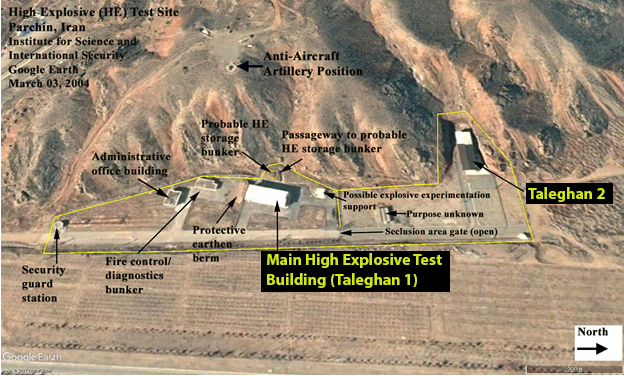
Figure 1. A 2004 Google Earth commercial satellite image shows the Parchin complex that was involved in nuclear weapons high explosive testing work under the AMAD project. This site has been extensively sanitized by Iran. The Israeli-captured Iran nuclear archive has extensive information on this site, in particular on the two main facilities which Iran calls in the documents Taleghan 1 and 2. Taleghan 1 contains the high explosive test chamber often discussed publicly and by the IAEA, and Taleghan 2 contained a smaller high explosive test chamber and a flash x-ray system not visited by the IAEA.
Not all of the buildings are discussed in the publicly available information from the Iran nuclear archive, including at least two buildings that have so far escaped characterization and require further on-site investigation by the IAEA.
It is worth noting that the layout of this site is not random, but follows a clear operational test engineering and safety logic. We assess that the site was well-designed for performing contained experiments with high explosives that are well-diagnosed in a controlled environment. All the buildings and bunkers in close proximity to the two explosive chamber buildings are protected by berms; some have berms on the sides facing the main explosive chamber building.
Main High Explosive Test Building
The explosive chamber building, called Taleghan 1, with two vents visible in some imagery, is located next to a distinctive earthen blast deflection berm faced with concrete, where the south end of the building is up against the berm’s vertical flat face.
Figure 2 is a photograph taken in the early 2000s from the archive showing the main building that holds a large high explosive test chamber. Major visible features of the building are annotated in the figure. We can say for certain that the photo was taken some time between when the building was first observed during early construction in 2000 and sometime before sanitization of the site began in 2012. This is due to the fact that the security fence (labeled at the far right on Figure 2), which encircled the west side of the probable high explosives storage bunker, was visible on satellite imagery from 2004 to 2011, but was removed by May 2012 and never replaced.
Figure 3 is a photo of the building from the side adjacent to the hillside retaining wall, or west wall of the building, that also shows a portion of the concrete-faced berm.
High Explosive Chamber. Figures 4, 5, 6, and 7 show the inside of the building, in particular the large chamber. A large central concrete block is visible.
Comparing Inside and Outside Images of Taleghan 1. Figure 8 is a Google Earth image from before Iran sanitized the building and site. This allows a comparison of the photos from the Iranian archive to satellite imagery. Figure 9 is a more recent Google Earth image that also allows comparisons.
The satellite images and the internal photos reveal several common attributes, including:
1. The concrete-faced berm adjacent to the main building is visible in both the ground and satellite imagery;
2. A grey access door on the east side of the building can be seen in Figure 2 and in the satellite images in Figures 8 and 9;
3. A row of five lower windows of five panes in Figure 2 can be seen in the satellite image in Figure 9;
4. A cylindrical tank with a cover can be seen in both Figure 2 and the satellite image in Figures 8 and 9;
5. Two vent stacks visible in Figure 2 are visible in the satellite image in Figures 8 and 9;
6. A manhole and a driveway with curbs are visible both in Figure 2 and Figure 8;
7. A vent pipe by the grey access door in Figure 2 is visible in Figure 8 as well. The yellow of this vent pipe in Figure 3 matches the yellow on the pipes inside the building (see Figures 4-7);
8. The grey access doors on the east and north side of the building in Figure 2 match the inside view in Figure 7;
9. The centerline of the chamber is slightly off-set to the east of the centerline of the building (see Figures 6 and 7). This same off-setting is seen in a 2000 satellite image during the early construction on this building (see Figure 10).
The multiple shared attributes show that the ground photo of the building matches the building in the satellite photos of the Parchin site. Moreover, visible characteristics of the building shown in internal photos of the building with the high explosive chamber match those in the ground photo of the outside of the building (Figure 2). This photographic analysis shows that Iran’s declaration that there was no chamber inside this building is both false, and erroneous.
Details about the Chamber. Prior to the Israeli release, the only publicly available visual information of the chamber in Taleghan 1 was a schematic published by George Jahn in an Associated Press article in 2012 (Figure 11).9 The newly released pictures confirm the accuracy of Jahn’s reporting but also demonstrate that the new photographs of the chamber constitute significantly more powerful evidence of the chamber than the schematic.
According to Jahn’s reporting, the chamber was operated under vacuum in order to minimize pressure that could damage the structure during an explosion. After a detonation, water is sprayed into the chamber to clean it, at least on an initial basis. There is a tank to receive the liquid waste.10
Jahn, who was based in Vienna, probably obtained this schematic and the accompanying information in his article from a member state that knew about the information already given to the IAEA. Early in this debate about this site, the IAEA received one or more images of the chamber, but they did not release these images publicly.
In its public reporting, however, the IAEA stated that this cylindrical chamber was used to conduct high explosive compression tests related to nuclear weapons development. Moreover, it matched the parameters of an explosives firing chamber featured in publications of a foreign expert who allegedly assisted Iran in designing and possibly setting up the chamber, which the Institute subsequently identified as ex-Soviet nuclear weapons expert Vyacheslav Danilenko.11
The Institute’s 2012 report, Revisiting Danilenko and the Explosive Chamber at Parchin: A Review Based on Open Sources, summarizes Danilenko’s writings, which describe a chamber that he designed in 1999 and 2000 that is strikingly similar to the one in the photos from the archives and capable of withstanding multiple explosions of devices up to 70 kilograms TNT equivalent.12
The IAEA also concluded that the chamber at Parchin is very similar to the one designed by Danilenko and described in his 2003 book, titled Sintez I Spekanie Almaza Vzryvom (Explosive Synthesis and Sintering of Diamonds), which a European official told Institute staff that Danilenko wrote based on lectures he delivered in Iran in the late 1990s and early 2000s.
The IAEA developed evidence that the former Soviet nuclear weapons expert not only aided in the development of the high-explosive testing chamber at Parchin, he also possibly provided help in using sophisticated diagnostic equipment for testing the spherical symmetry of high explosive shaped charges.13 Danilenko must have known the potential for Iran to apply his expertise to the development of nuclear weapons. Ostensibly, Danilenko claimed that he was only working to make nanodiamonds with high explosives in these types of chambers. According to Danilenko himself, however, when discussing his work on nanodiamonds in the Soviet Union: “At that time, experiments aimed at methods for diamond synthesis were highly classified because they depended on considerable knowledge applicable to the design of nuclear weapons. For security reasons, the methods were initially contained only in secret reports from the VNIITF [Chelyabinsk-70]. Only in 1987 were parts of those reports forwarded to other members of the diamond club.”14 Danilenko likely contributed significantly to Iran’s nuclear weapons program.
Other information in the archives raises the question of whether Iran received additional assistance from some other former Soviet nuclear weapons experts.
Starting Up the Chamber. The facility was operational by early 2003, based on another document in the archive. This document describes the contamination level caused by a “raw material” used in a chamber experiment conducted on February 15, 2003.15 The intent appears to have been to test the chamber prior to routine operation to ensure the chamber worked as designed and radioactive material was not released into the hanger holding the chamber. The test was overall judged a success from the point of view of health and safety, with some recommended future actions that are discussed below. The health and safety manager reported to the head of Project 3030 (unidentified as to purpose), with a copy to the head of Project 110, his principal finding that “regular tests in the chamber are authorized.” Thus, the date of the document in February 2003 can be viewed as the start of the routine operation of the Taleghan chamber.
At one point in the document, this raw material is referred to as “U,” strongly suggesting that it was uranium (particularly so, given that the IAEA detected uranium particles onsite via Iranian conducted environmental sampling and that there is the new Iranian reporting of uranium in both neutron generators tested at the site as well as in waste at the site, see below). The use of the term “neutron source” in the document would also imply that the object tested was explosively driven and, upon compression, produced a spurt of neutrons. The most likely candidate for this object is a uranium-deuteride (UD3) neutron source (see section below). This is also consistent with Jahn’s 2012 reporting that the large chamber was used to test “a small prototype neutron device used to spark a nuclear explosion,” a layman’s way to describe a neutron initiator.16 In any case, the test of a neutron source was a critically important aspect in Iran’s development of nuclear weapons. Figure 12 is an Iranian schematic from the archive that shows a neutron source placed at the center of a nuclear explosive.
According to the document, the raw material arrived at the Parchin site with a “cover,” e.g. encased, and no contamination was observed. As a result, no special precautions were taken during the assembly of the “part,” which again is undefined, likely for information security reasons. Likewise, the assembly location is not identified in this document. But the document makes clear that this part was tested in the experiment. Following the test, “no radiation was measured outside the chamber,” states the author, implying that the chamber worked as designed and the initial negative pressure inside the chamber (under vacuum) apparently led to the venting of material into the atmosphere. Afterward, the chamber’s shower system was used once to wash the chamber. After waiting 24 hours to let the residue settle, ventilation began, and the chamber door was opened (see Figures 4 and 5). One problem was that the chamber’s ventilation system did not create a sufficient air-flow to the external venting pipes, causing some of the toxic gases to escape the chamber through the opened door into the room, and leading personnel to inhale it. Certain high explosive products, such as oxides of nitrogen and carbon monoxide, are toxic.
At an unidentified time after the opening of the door and the beginning of the venting of the chamber, a person with appropriate safety gear entered it and collected the “crude waste” inside the chamber and then manually cleaned it. Before this person washed the chamber, he or she took some samples near the location of the explosion and from the floor near the door. These samples showed an average of 10 CPS, which may mean counts per seconds registered by the detector, which is undefined. The manager wrote that the values were higher than the “baseline” but well below radiation health and safety guidelines. In this report, the health and safety manager used the guidelines of the U.S. Environmental Protection Agency (EPA) for safe limits of uranium in water and solid wastes.17 Additional samples were taken of chamber waste, from the waste tank, and from “regular water.” The uranium concentration in the liquid samples was higher than the “baseline” for the chamber but well below the allowed level of uranium concentration in liquids set by the EPA. The uranium concentration in the samples of solid waste from the chamber was significantly higher than that in the liquids, but still well below the regulatory limit.
The manager’s overall conclusion was that the chamber was “ready for regular tests, as long as the shower is not used.” He did not explain the exact reason why he was concerned about the use of the chamber’s shower. Although the measured radiation levels were within the standards, perhaps there was concern about the chamber’s shower needlessly spreading radioactive contamination. He added that in the case of the “need to repeat neutron source tests,” several additional instructions should be followed, apparently aimed at reducing potential contamination levels to personnel, such as having a “shower/bath” and apparently a changing closet, and better containing the wastes.
Figure 2. Image from the archive seized by Israel and made available to the public. As discussed in the text, it shows the main building at the Parchin site. Annotations by the Institute.
Figure 3. Image from the archive seized by Israel and made available to the public. As discussed in the text, it shows west wall of the main building at the Parchin site and an associated tent. Annotations by the Institute.
Figure 4. Image from the archive seized by Israel and made available to the public. As discussed in the text, it shows a high explosive test chamber at the Parchin site. Annotations by the Institute.
Figure 5. Image from the archive seized by Israel and made available to the public. As discussed in the text, it shows a personnel door to a high explosive test chamber at the Parchin site. Annotations by the Institute.
Figure 6. Image from the archive seized by Israel and made available to the public. As discussed in the text, it shows a high explosive test chamber at the Parchin site. Annotations by the Institute.
Figure 7. Image from the archive seized by Israel and made available to the public. As discussed in the text, it shows a high explosive test chamber at the Parchin site. Annotations by the Institute.
Figure 8. Google Earth satellite image showing main characteristics of Taleghan 1. Annotations by the Institute.
Figure 9. Google Earth satellite image showing location of underground storage bunker near Taleghan 1. Annotations by the Institute.

Figure 10. GeoEye-ISIS satellite image showing early construction of Taleghan 1 and associated facilities. Annotations by the Institute.

Figure 11. Schematic of the high explosive chamber inside the main building at the Parchin site. Source: Associated Press and Israel.

Figure 12. A nuclear weapon schematic in the archives that shows a neutron source at its center. From the bottom, and proceeding counterclockwise, the terms in the boxes are neutron source, uranium 235 core, air gap, flyer plate, main charge, “detonation distributor,” and outer casing. Thanks to Behnam Ben Taleblu for translation.
Probable High Explosive Storage Bunker
To the west of the explosive chamber building, and accessible by an angled concrete-walled passageway, is a probable underground high explosives storage bunker. Its foundation is visible in a 2000 image of the site (Figure 10). The IAEA did not visit or address this building in its reporting, but it requires further investigation.
After retrieving explosives from this bunker, Iran likely prepared the experimental devices in a small building nearby, which had berms on two sides. This building was demolished and rebuilt after 2012.18 It is marked as a possible explosive experimentation support building in Figure 1 and was possibly involved in supporting high explosives experimentation activities.
Another building further from the explosive chamber building was dismantled in 2012 and not rebuilt. It is annotated as purpose unknown in Figure 1. This building may have been involved in the assembly of devices. In this case, the building would have mated explosives and detonators for later experimentation in the explosive chamber buildings. This building was isolated enough that if the explosives accidentally detonated, nothing in the proximity would be damaged. After preparing the high explosive devices, Iran would then have tested the assembled devices in the explosive test chambers. There was also an administrative building nearby.
Second High Explosive Chamber Laboratory
There is one additional, relatively large, rectangular building located at the north end of the site that was built into the hillside and was also not addressed by the IAEA in its reporting. The IAEA has not visited this building, called Taleghan 2. Construction of this roughly 40 meters-long building started after that of the main chamber building. As was the case with Taleghan 1, this building was extensively modified after 2012, including modifications that took place under a pink translucent (likely plastic) tarp.
The building consists of a long hall oriented toward the cut-out hillside, which logically serves as a natural backstop in the event of an accident at the far end. Moreover, that receiving end seems to have involved different construction (see Figure 13). On the opposite end is a personnel access door.
The Iranian nuclear archive contains information about this building. Originally, the Institute assessed it to have been a research and development test hall linked to nuclear weapons development, probably shock physics experimentation, given the orientation of the long axis of the building backstopped into the hillside – a design that would be advantageous for activities involving projectile impact studies. However, the archive shows that this building contained a smaller, elongated high explosive chamber and a flash x-ray system to examine small-scale high explosive tests, in particular to evaluate explosions of hemispherical components in the AMAD program, according to an Israeli handout to the media.19 Figure 14 is a composite of pictures showing the chamber being constructed in the building. Such tests may have included high explosives compressing a core of natural uranium, simulating the initiation of a nuclear explosive. The flash x-ray would allow the dense nuclear core surrogate to be seen inside the high explosives, as they detonate and compress the core.20 It would allow the filming of the compressed surrogate material sequentially as it is compressed. Such experiments, which would have spread uranium, would explain why Iran sought to also sanitize this building in the same manner used to sanitize Taleghan 1.
Parts of the flash x-ray are visible in Figure 15. According to the information provided by senior Israeli intelligence officials to the Institute and the media, the Marx generator, also pictured in Figure 15, produced a high voltage pulse for the flash x-ray used inside Talaghan 2.21
Figure 16 is an image from the archives that shows Mohammad Mehdi Tehranchi (Persian: محمد مهدی طهرانچی) at a test of the flash x-ray in Taleghan 2. At the time, he was in charge of project 3/20. He is a physicist who studied in Russia. Currently, he is acting president of Islamic Azad University and head of the Supreme Council for Science, Research and Technology commission. Formerly, he was, inter alia, the head of Shahid Beheshti University. According to a document in the archives, he is also currently affiliated with SPND, the direct descendant of the AMAD plan and the most recent incarnation of Iran’s nuclear weapons effort. Because of his direct connection to alleged nuclear weapons development activities, he should be interviewed by the IAEA.
Figure 13. Google Earth image of Taleghan 2. Annotations by the Institute.
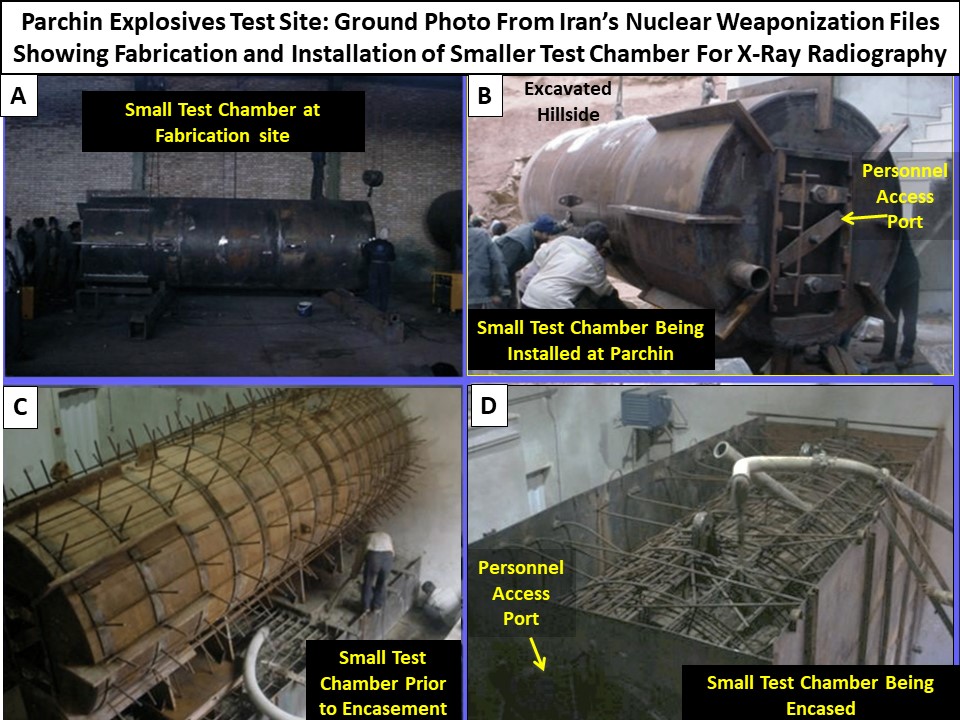
Figure 14. Images from the archive seized by Israel and made available to the public. As discussed in the text, it shows a composite of the smaller high explosive test chamber being constructed inside Taleghan 2 at the Parchin site. Annotations by the Institute.
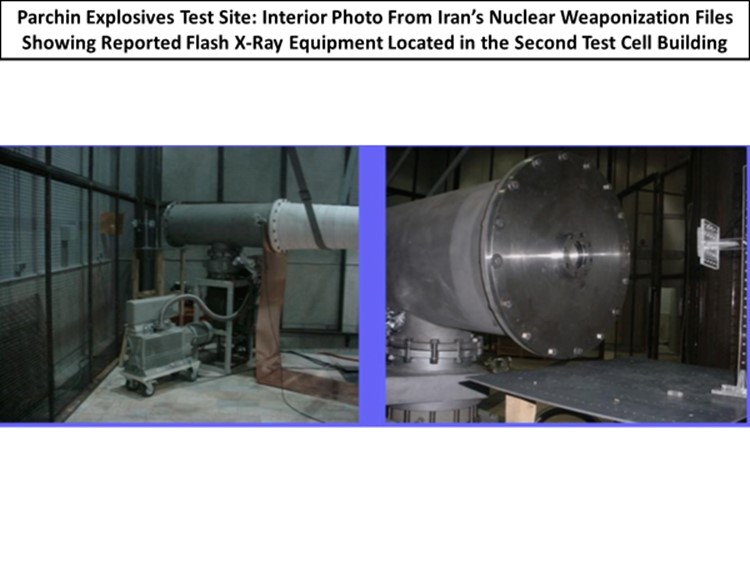
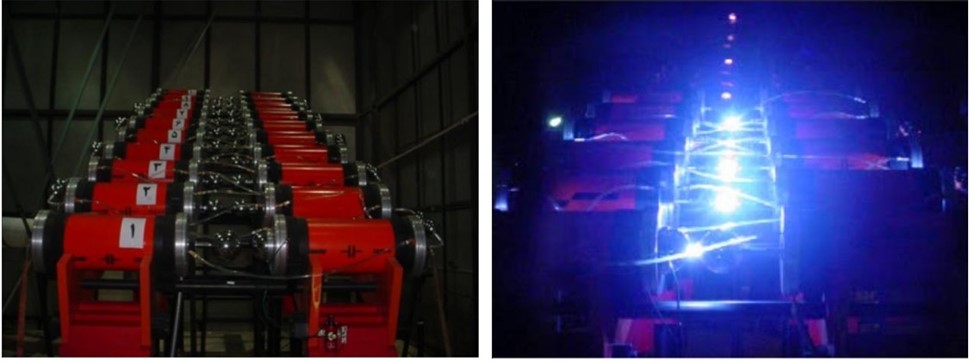
Figure 15. Flash X-Ray system for nuclear-related testing in Taleghan 2 (upper). Below is a Marx generator in Taleghan 2 used as part of a flash x-ray to deliver fast pulses of energy to enable a rapid succession of images to be taken.
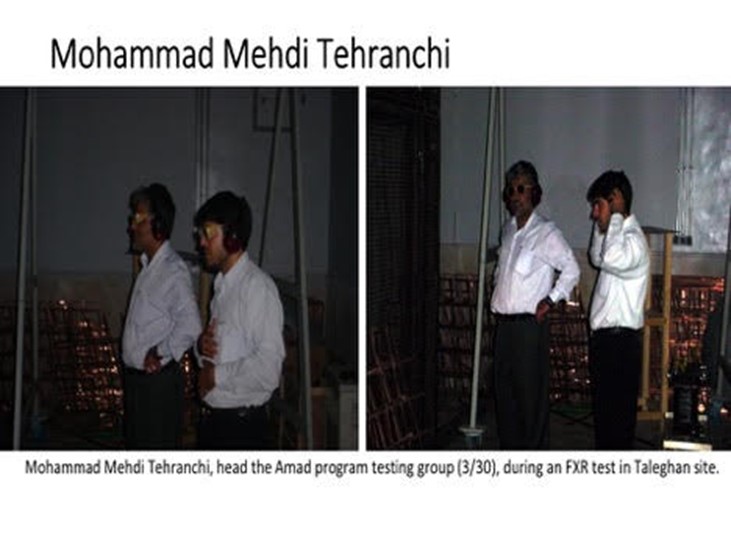
Figure 16. Mohammad Mehdi Tehranchi (on left in both images), head of AMAD subproject 3/30, at a test of the flash x-ray (FXR) in Taleghan 2, according to Israelis knowledgeable about the archive.
Manufacture of the Large Chamber in Taleghan 1
The archive also contains pictures of a large chamber being fabricated at an unidentified factory. The IAEA had earlier obtained a photo of the chamber installed at Parchin that was built by the Iranian company Azar AB Industries.22 The interior of the unidentified factory is consistent with the exterior of the Azarab factory located in Arak, Iran, which is known to have fabricated oil distillation columns as shown in a Youtube video see Figure 19.23
Figure 17. Manufacture of a large high explosive chamber. Source: Israel.
Figure 18. Manufacture of a large high explosive chamber. Source: Israel.
Figure 19. Azar AB Industries Foundry, Arak, Iran. Probable location of site where large high explosive chamber was manufactured.
Subproject 3/21: Neutron Initiator Tests
There have been allegations for several years that Iran conducted high explosive compression tests of a neutron initiator made from uranium and deuterium (UD3) in the high explosive chamber in Taleghan 1. The uranium serves as the carrying material for the deuterium. Such neutron sources are used to trigger a nuclear weapon made from weapon-grade uranium. They have a long life, meaning they do not need to be replenished like several other types of neutron initiators used in nuclear weapons. Despite Iranian denials, the new information adds to the case that the explosive chamber in Taleghan 1 conducted these types of tests.
The neutrons in this type of source are produced through the fusion of two deuterium (D) nuclei, where the energy needed to achieve D-D fusion comes from the compression caused by the high explosives. In essence, the high explosives compress the nuclear core and the initiator at its center, producing a spurt of neutrons as a result of fusion in D-D reactions. The neutrons flood the core of weapon-grade uranium and initiate the chain reaction in the nuclear explosive material, e.g. weapon-grade uranium. It does not boost the yield. Figure 20 shows the placement of such an initiator in a nuclear weapon design advertised by the Pakistani A.Q. Khan on the cover of one of his books (see also Figure 12).
The measurement of the neutrons emitted by this UD3 source would be one of the most difficult measurements Iran would need to make in developing a nuclear weapon. The Iranians would also need to perform accurate calculations about the number of neutrons that would be produced and the time at which they would be produced. The timing of the explosion and resulting shock waves would need to be near perfect in order to get enough fusion to create a spurt of neutrons in a reliable manner at exactly the right instant. The experiment itself is very difficult to do. There are relatively few neutrons emitted in a brief period of time and there is a lot of noise from the electronics in the detectors that interferes with the neutron measurements.
The archive has an Iranian slide presentation relevant to these tests under what is called “subproject 3/21,” which was focused on neutron measurements. Interestingly, a slide from an Iranian presentation in the archive lists subproject 3/20 as in charge of manufacturing uranium deuteride (UD3), where according to the design, this type of source is to be used in the “main system,” likely code for nuclear weapon. The slide summarizes in a credible manner how to make UD3, starting with uranium metal chips and deuterium gas.
With regard to the document on subproject 3/21, Israel made only five slides public out of a total of ten or more. The slides are dated May 22, 2003. The second slide lists the main activities of this project:
1. Measurement of discrete and continuous neutron flux of continuous and pulsed sources, explosive and non-explosive; 2. Use of a nuclear spectrometer to identify radio-isotopes and materials’ analysis.
The next several slides are all titled “Results of Taleghan Test.” The first shows an experimental arrangement, with English annotations identifying a large Boron trifluoride (BF3) neutron detector (Figure 21) against the high explosive chamber. It is labelled “Big BF3-1,” where the number one at the end may refer to detector number. Figure 22 shows a picture from the presentation with annotations pointing to more neutron detectors at an unknown location, although they look to be against the side of the large explosive chamber. Annotated is a commercially available NE-213 liquid-scintillator detector, two activation counters, and a CR-39 track detector. The last available slide shows a control point inside a tent outside the main chamber building (see Figures 3 and 23).
These neutron detectors are well known. In their organization as given in the two figures, they look to be part of a neutron measuring system used in nuclear weapon states in the development of nuclear weapons. These detectors can reveal the total number of neutrons emitted and their energy spectrum. Moreover, the choice of the detectors provided a backup capability, increasing the chances that the experiment will accurately record the neutron emissions and produce a permanent record of the total number produced. One expert we consulted judged the approach “clever.” Overall, subproject 3/21 appears to have sought the best detector systems for detecting a short pulse of neutrons produced during the compression by high explosives of a uranium deuteride neutron source.24
Post-2004 Work. The sudden ending of the effort at Parchin apparently happened before the experimental work on detectors or neutron sources, including UD3 sources, was finished. An Iranian document, which is an introduction to a larger report, released by The Times of London in December 2009, titled “Outlook for special neutron-related activities over the next 4 years” appears increasingly legitimate and describes an Iranian plan by the “neutron group” in a “Centre” apparently at the Institute for Physics to further develop, produce, measure, and test pulsed neutron sources, as well as conduct calculations and simulations.25 Like other Iranian nuclear weapons related documents, this one appears deliberately opaque in its descriptions of key activities. Nonetheless, the document, which is dated to 2007, suggests that although work on neutron sources made progress in the past, it was reduced in scale at some point. The plan was to increase that work over four years.
The plan includes a prioritization of subjects “in the light of the current political climate and our existing capabilities.” The document implies work on the production and testing of a UD3 initiator. It also discusses continuing the work on replacement materials, such as another one made from titanium deuteride (TiD2) in order to “avoid U pollution from the production of UD3.” One aspect discussed in the document is this project’s need for better neutron detectors and associated electronics, although it acknowledges that the group has already made important accomplishments in this area. “For those areas that fall short of requirements, we must attempt to resolve the situation by creating, designing, and purchasing solutions under the ordinary project arrangements,” in consultation with the project’s scientific consultants.
It also states a requirement for increased staff, including two persons with Ph.D.’s and four with Masters degrees, to do neutron calculations. In selecting personnel to carry out the calculations, the document notes that are “insufficient numbers of personnel to cover the field of neutron calculation.” It adds that “if they are to be employed, specific safeguards must first be put in place. The most appropriate way of obtaining the required personnel is to employ individuals who were involved in the relevant calculation projects in the past.”
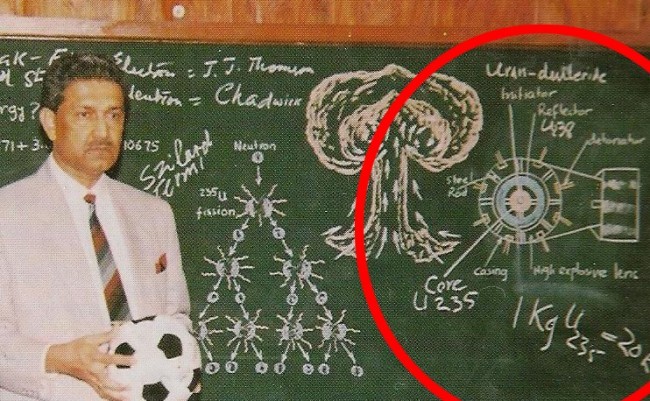
Figure 20. An image from the cover of the book Dr. A.Q. Khan on Science and Education, by A.Q. Khan. An illustration of a uranium deuteride neutron initiator at the center of what appears to be a schematic of a fission nuclear weapon is inside the red circle.

Figure 21. A large boron trifluoride (Bf3) neutron detector outside the main explosive chamber, with a view looking to the north. Annotations on original photo supplied by Israel. The term “Big Plastic” appears to be neutron scientists’ jargon for the plastic being thick enough to absorb all the incident neutrons, e.g. it is 100 percent efficient, according to Dr. Konovalov.

Figure 22. A NE-213 liquid-scintillator detector, two activation counters, and a CR-39 Polyethylene track detector, apparently set up next to the high explosive chamber. Annotations on original photo supplied by Israel.
Figure 23. Google Earth satellite image of Taleghan 1, showing the former location of the neutron counter recording tent. See also Figure 3.
Findings and Recommendations
The new information from the Iranian nuclear archive conclusively shows that the Parchin site did house high explosive chambers capable for use in nuclear weapons research and development. The additional evidence specifically mentions explosions and radioactivity at the Parchin site, and this information far more vividly establishes Iran’s nuclear weapons-related activities there.
The nuclear archive shows that Iran conducted at Parchin more high explosive tests related to nuclear weapons development than previously thought. This work appears to have involved more than what the IAEA called feasibility and scientific studies, or the acquisition of certain relevant technical competences and capabilities, as the IAEA asserted in its December 2015 report.
The information highlights dual-use, controlled equipment used at the site, such as a flash x-ray system utilizing a Marx generator and a variety of neutron measurement equipment, with electronics, designed to monitor high speed, explosively driven tests of a neutron source commonly used in a nuclear weapon. This type of equipment can be expensive and very difficult for Iran to obtain, given sanctions and export controls. As a result, it would be expected that Iran has stored this equipment for future use or assigned it to other projects. An important question is: where is it now? Unless Iran can demonstrate it has destroyed all the equipment or is not utilizing it, this photographic evidence should be sufficient to initiate an action by the Joint Commission to subject this equipment to control and monitoring under Section T.
More broadly, at issue remains whether Iran is simply preserving, curating, and improving its nuclear weapons capabilities, awaiting a decision to reconstitute a full-blown nuclear weapons program at a later date, if such a political decision is made. Its failure to destroy all these documents, and purportedly, the equipment used in these activities, does not align with its commitment under the JCPOA “that under no circumstances will Iran ever seek, develop or acquire nuclear weapons.” In the case of South Africa, giving up its nuclear weapons program involved program officials searching for and burning all nuclear weapons sensitive documents and destroying the sensitive components, equipment, and non-nuclear materials.
Despite all the evidence, the IAEA has received mixed support from the Joint Commission in assessing the site. During the negotiations of the JCPOA, the Obama administration decided not to insist on including the resolution of the Parchin and broader nuclear weapons issues as a precondition for arriving at a nuclear deal or implementing it. This unwise political decision continues to haunt the entire Iran issue today.
The IAEA needs access to the Parchin site and associated facilities, such as the company or companies where the high explosive chambers were manufactured, as well as individuals identified as having worked during this time period at the site. Environmental sampling should be conducted at all the buildings at the site. The inspectors need to see the cut-up chambers and associated equipment and be able to take environmental samples there as well. Iran must have put all of these items somewhere. The lack of access to Parchin and other military sites continues to undermine the credibility and independence of IAEA safeguards and the verification of the JCPOA.
The evidence reinforces that Iran was violating the NPT in the early 2000s in a more significant manner than previously understood and fully intended at that time to continue work toward having the option to build nuclear weapons and deceive the IAEA in that endeavor. There is no proof that Iran has abandoned its goal of building nuclear weapons, only that it has accepted that its projects and plans are put on the shelf. Is it hiding on-going activities and progress, albeit operating at a reduced scale compared to the program that existed before 2004? Should not Iran verifiably destroy all its nuclear weapons documentation and equipment? There is no way to know without more and effective IAEA inspections.
Given the length of this controversy, Iran’s obvious deceptions about its activities at this site, the advanced level of nuclear weapons development work done there, and the challenges posed by the site’s legacy, the Board of Governors bears its share of the responsibility for the lack of adequate inspection of this site and the failure to fold new information into the IAEA’s broader challenge of ensuring that Iran’s nuclear program is actually peaceful.
Interestingly, the U.S./E3 talks throughout the first half of 2018 aimed at reaching a supplementary deal to “fix” the JCPOA, which unfortunately failed to preserve U.S. participation in the deal, did reach agreement on the need to improve inspections in Iran. Drawing on that consensus, the E3 and the United States should urge the IAEA to substantially enhance its inspections in Iran. The E3 should pursue full implementation of both the JCPOA and Section T, as it seeks to preserve the JCPOA and resist any efforts to weaken its provisions or implementation. All four countries, as a matter of policy, should quietly and regularly urge the IAEA to re-visit the Parchin site as part of its effort to reach a Broader Conclusion for Iran and ensure Iran’s nuclear program is truly peaceful. The IAEA should more generally use the information in the seized archives to expand inspections and monitoring in Iran and build a stronger public characterization of Iran’s past nuclear weapons work. This new information, as exemplified by Parchin, inevitably leads to a renewed urgency to look again at the question of whether Iran is maintaining and advancing a nuclear weapons program today using, inter alia, the newest organization named SPND mentioned in the IAEA reports. It is also vital for the inspectors to have full, unrestricted access to relevant technical and scientific personnel, equipment, and sites.
Annex Figure A.1

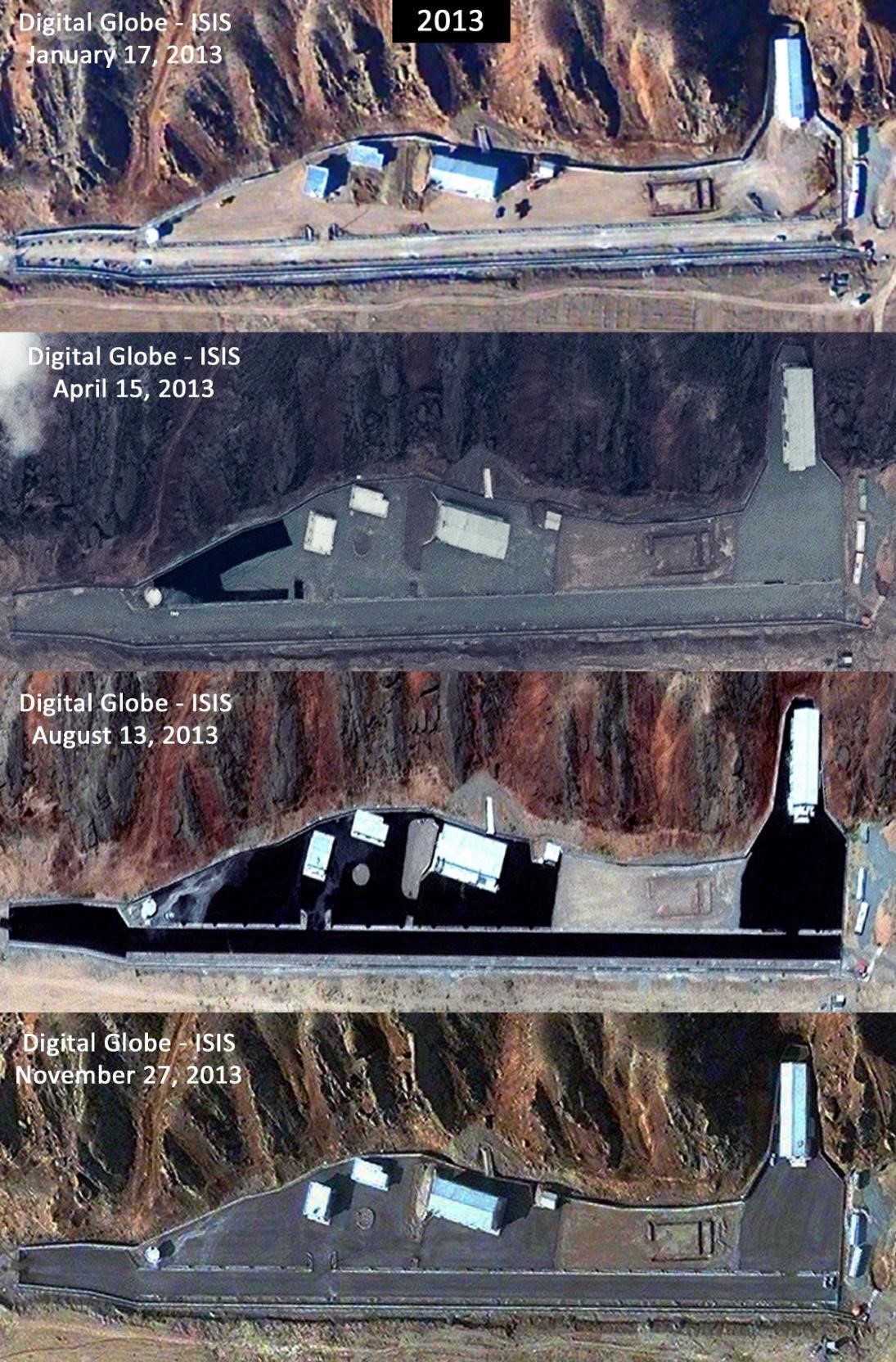
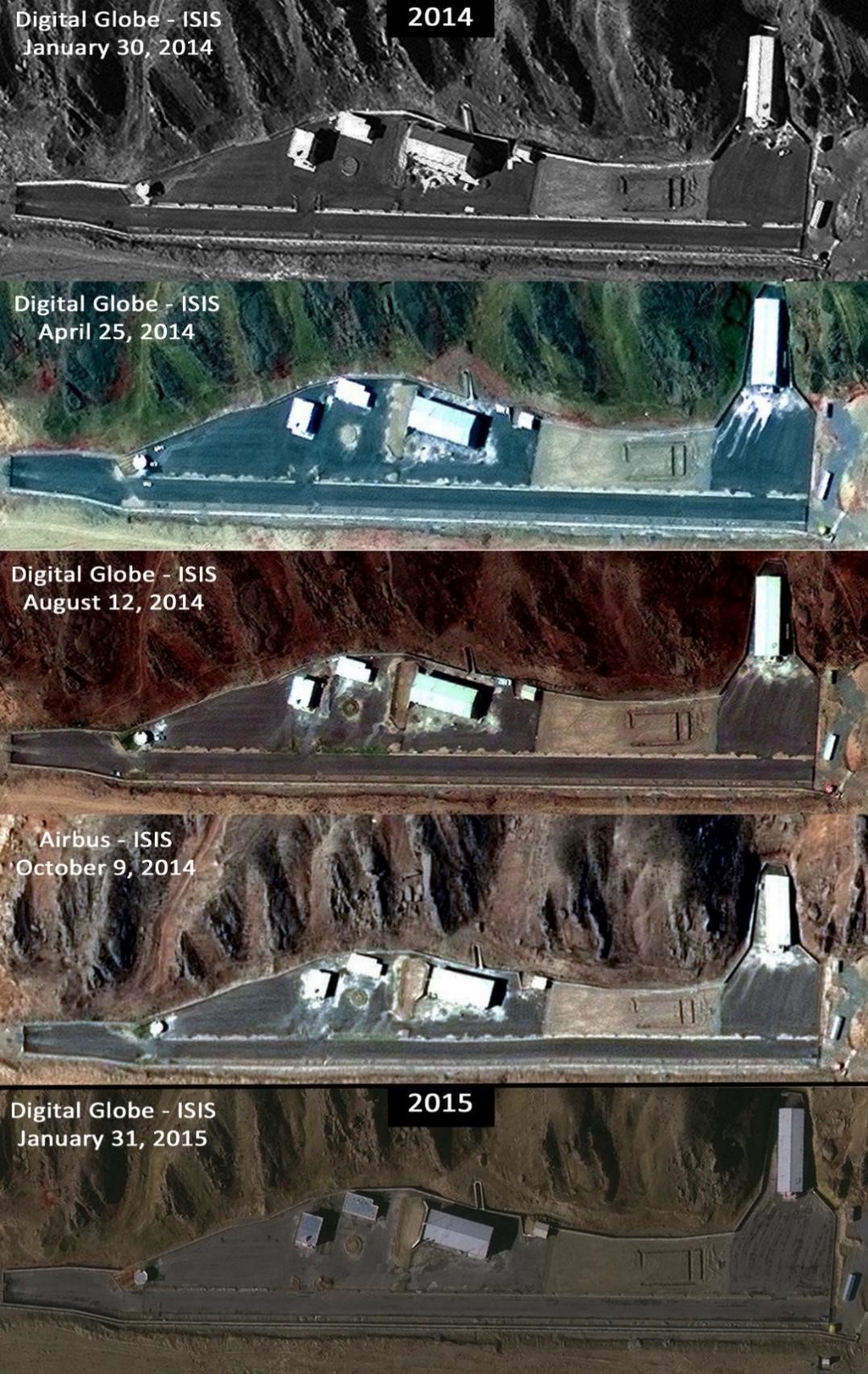
1. Olli Heinonen is Former Deputy Director General of the IAEA and head of its Department of Safeguards. He is a Senior Advisor on Science and Nonproliferation at the Foundation for Defense of Democracies.
2. Frank Pabian is a retired Los Alamos National Laboratory (LANL) Fellow from both the Global Security and Science-Technology-Engineering Directorates, most recently in the Geophysics Group, Earth and Environmental Sciences Division, with 45 years of experience in satellite remote sensing for nuclear nonproliferation. He also served in the 1990s as a United Nations Nuclear Chief Inspector in Iraq for the IAEA.
3. Prime Minister Benjamin Netanyahu, Presentation, April 30, 2018, https://www.youtube.com/watch?v=qmSao-j7Xr4↩
4. IAEA Director General, Final Assessment on Past and Present Outstanding Issues regarding Iran’s Nuclear Programme, IAEA, GOV/2015/68, December 2, 2015, https://www.iaea.org/sites/default/files/gov-2015-68.pdf↩
5. Final Assessment on Past and Present Outstanding Issues regarding Iran’s Nuclear Programme, Para 87. ↩
6. Controls on dual-use equipment are in subsection 82.3 of Section T: “Designing, developing, fabricating, acquiring, or using explosive diagnostic systems (streak cameras, framing cameras and flash x-ray cameras) suitable for the development of a nuclear explosive device, unless approved by the Joint Commission for non-nuclear purposes and subject to monitoring.”↩
7. David Albright, Sarah Burkhard, Olli Heinonen, Allison Lach, and Frank Pabian, Revisiting Parchin, Institute for Science and International Security, August 21, 2017, http://isis-online.org/isis-reports/detail/revisiting-parchin/8↩
8. “Re-Planning 110 According to New Instructions,” original in Farsi. A forthcoming Institute report will assess this document and additional evidence of post-AMAD institutional arrangements to research and develop nuclear weapons.↩
9. George Jahn, “Drawing may provide insight into Iran’s nuclear intentions,” The Associated Press. May 13, 2012.↩
10. Ibid.↩
11. David Albright, Paul Brannan, Mark Gorwitz and Andrea Stricker, “ISIS Analysis of IAEA Iran Safeguards Report: Part II - Iran’s Work and Foreign Assistance on a Multipoint Initiation System for a Nuclear Weapon,” Institute for Science and International Security, November 14, 2011, http://isis-online.org/isis-reports/detail/irans-work-and-foreign-assistance-on-a-multipoint-initiation-system-for-a-n/↩
12. See David Albright and Robert Avagyan, “Revisiting Danilenko and the Explosive Chamber at Parchin: A Review Based on Open Sources,” Institute for Science and International Security, September 17, 2012, http://isis-online.org/isis-reports/detail/revisiting-danilenko-and-the-explosive-chamber-at-parchin-a-review-based-on/, and Mark Gorwitz, “Revisiting Vyacheslav Danilenko: His Origins in the Soviet Nuclear Weapons Complex,” Institute for Science and International Security, September 17, 2012, https://isis-online.org/uploads/isis-reports/documents/Gorwitz_Revisiting_Vyacheslav_Danilenko_17Sept2012.pdf↩
13. Ibid.↩
14. From Danilenko, V.V. (2004), “On the History of the Discovery of Nanodiamond Synthesis,” Physics of the Solid State, 46 (4), pp. 595-599. See also: http://isis-online.org/isis-reports/detail/revisitingdanilenko-and-the-explosive-chamber-at-parchin-a-review-based-on/8↩
15. From Manager of Safety and Hygiene, to the Honorable Executor of Project 3030, with a copy to executor of Project 110, February 24, 2003, No. 1434, Top Secret.↩
16. Jahn, “Drawing may provide insight into Iran’s nuclear intentions.”↩
17. For example, the manager who wrote the document used EPA community water radiation standards of a maximum contaminant level (MCL) of uranium of 30 micrograms per liter, which is about 300 parts per billion (ppb), the unit in the document.↩
18. See http://isis-online.org/uploads/isis-reports/documents/Parchin_site_activity_May_30_2012.pdf↩
19. Handout provided by Israel explaining several documents and photos, including the flash x-ray.↩
20. If Iran used this flash x-ray after the JCPOA’s Implementation Day, it should have reported it under Section T.↩
21. Handout provided by Israel explaining several documents and photos, including the picture of the Marx generator.↩
22. Azarab Industries Company (Persian: شرکت صنایع آذرآب) is a large Iranian manufacturer of power plant and oil, sugar and gas refinery equipment in the Middle East. Azarab Factory is located in Arak. As of 2005, Azarab Industries, headquartered in Tehran, Iran, employed more than 2,500 people. Their main products are boilers, butterfly valves, turbines, and pressure vessels. See: https://www.revolvy.com/page/Azarab-Industries-Company↩
23. Location at 34°4’54”N, 49°44’42”E. YouTube video: https://www.youtube.com/watch?v=Xh_7vs24gi0↩
24. The Institute wishes to acknowledge the contribution to this analysis of Dr. Vitaly Konovalov, a former neutron physicist who worked in Russia and CERN.↩
25. Institute for Science and International Security, “New Document Reopens Question on Whether Iran’s Nuclear Weaponization Work Continued Past 2003, December 14, 2009, http://isis-online.org/isis-reports/detail/new-document-reopens-question-on-whether-irans-nuclear-weaponization-work-c/8. Farsi and English versions of the document are at: http://isis-online.org/isis-reports/detail/farsi-and-english-versions-of-document-on-neutron-initiator/↩


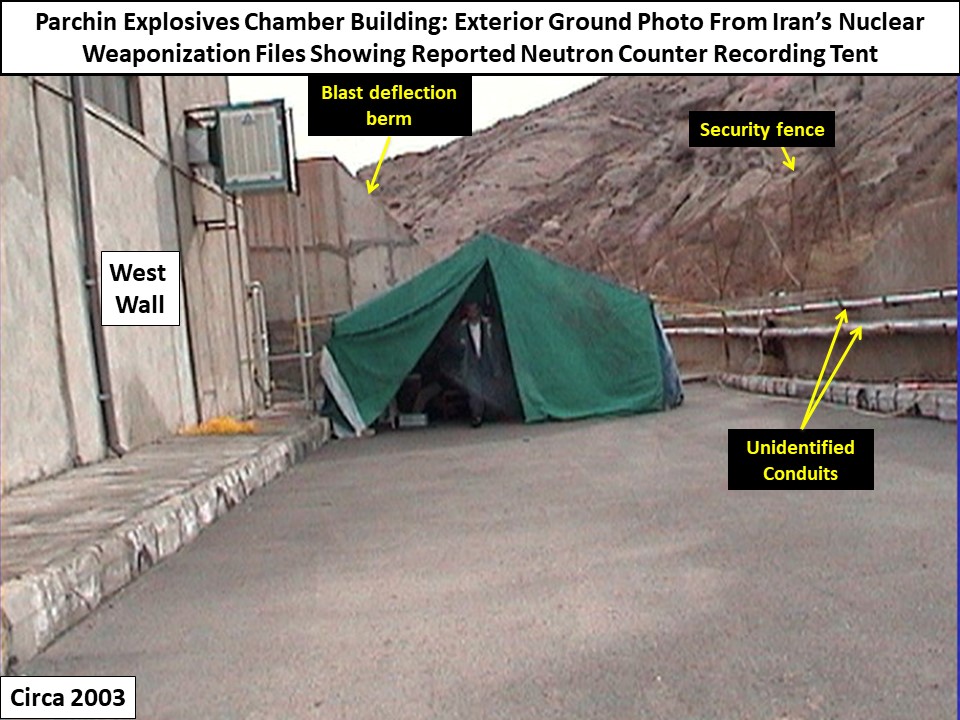
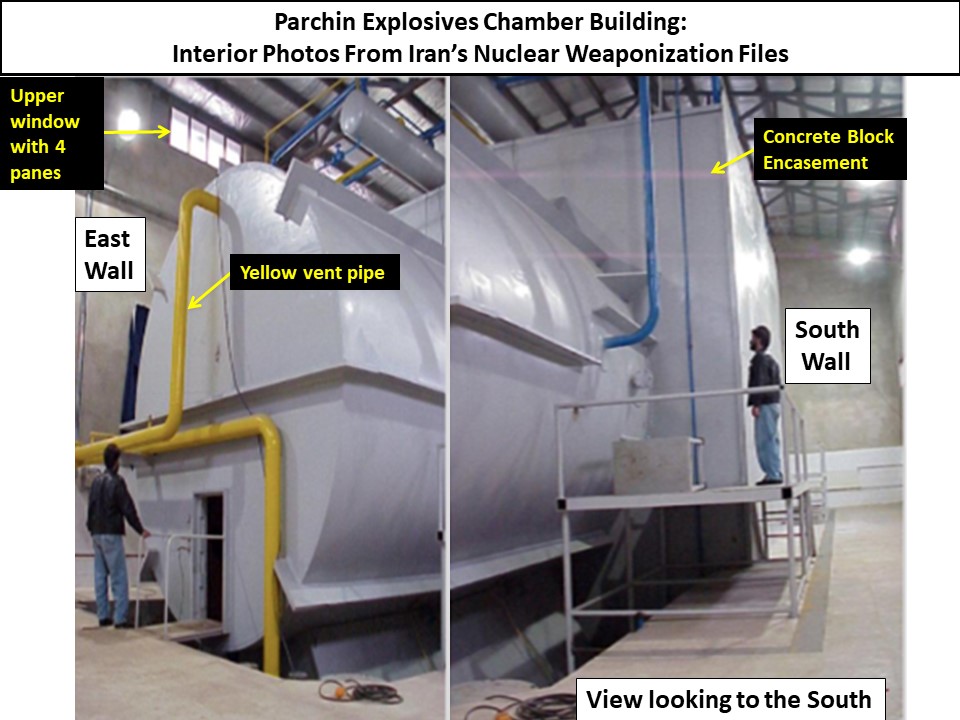

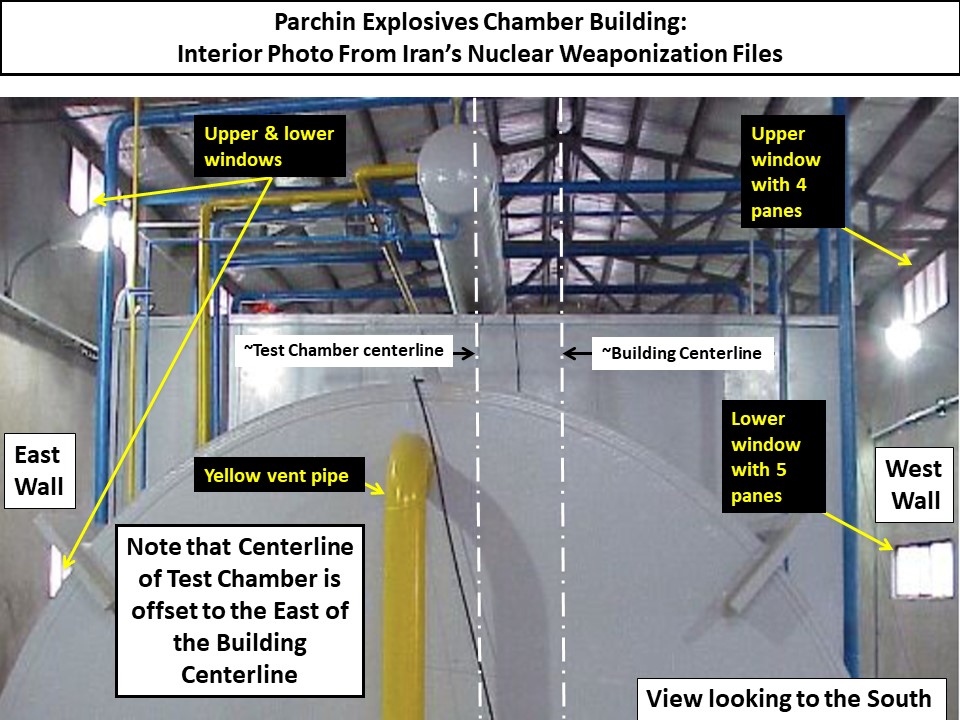
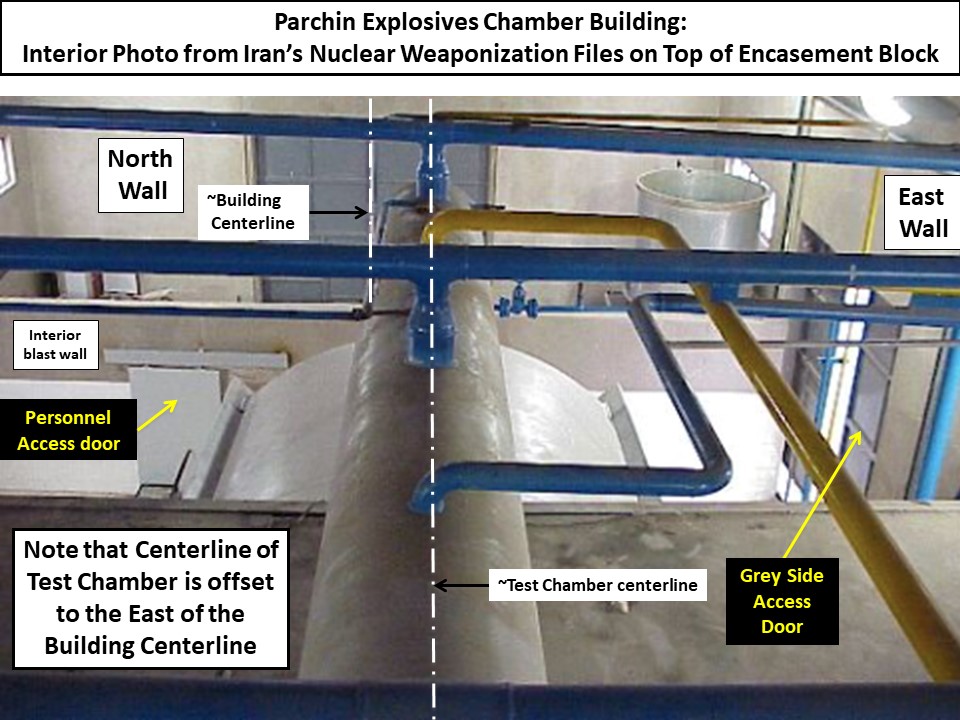
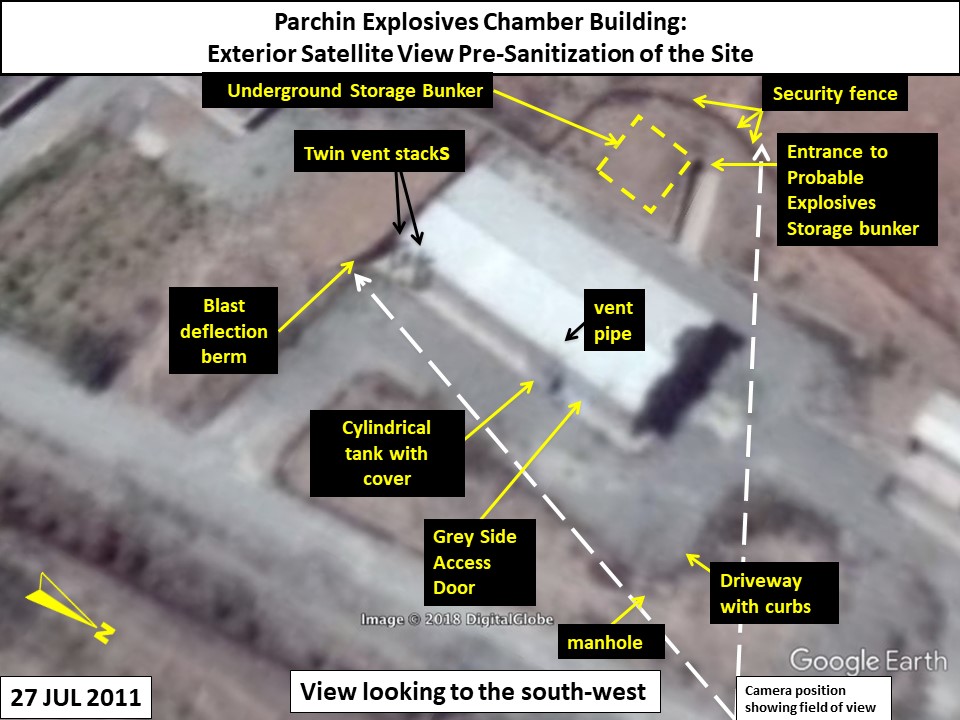
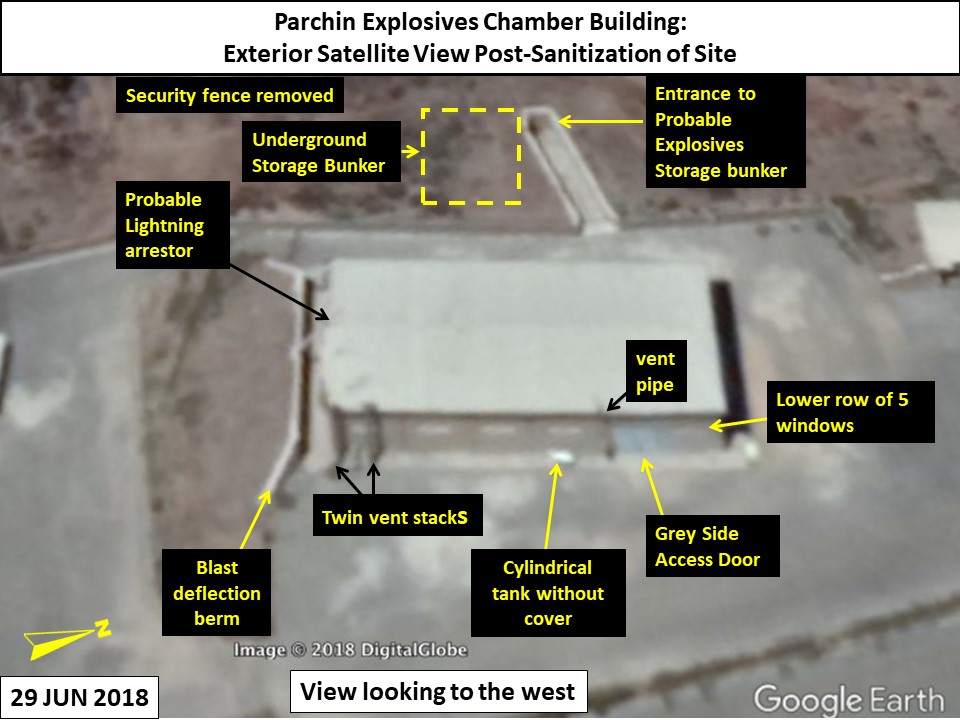
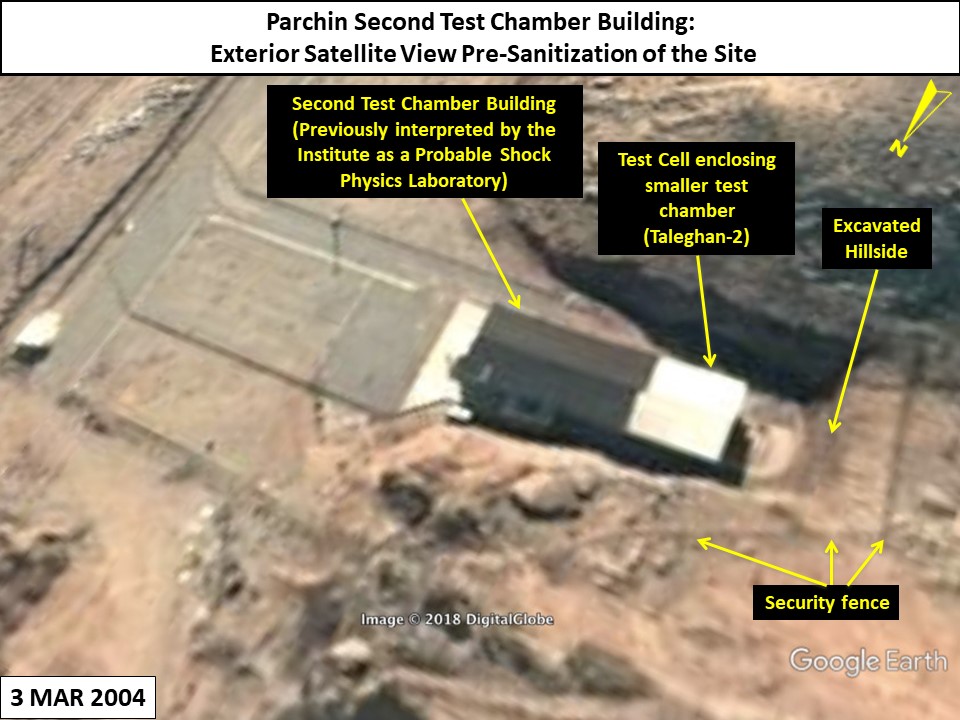
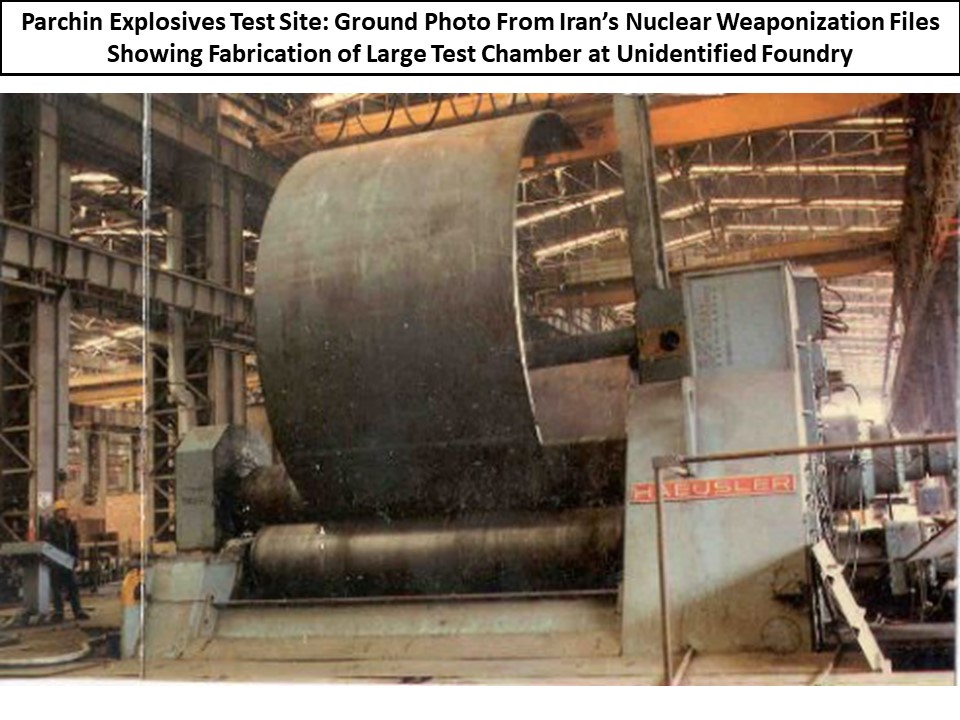
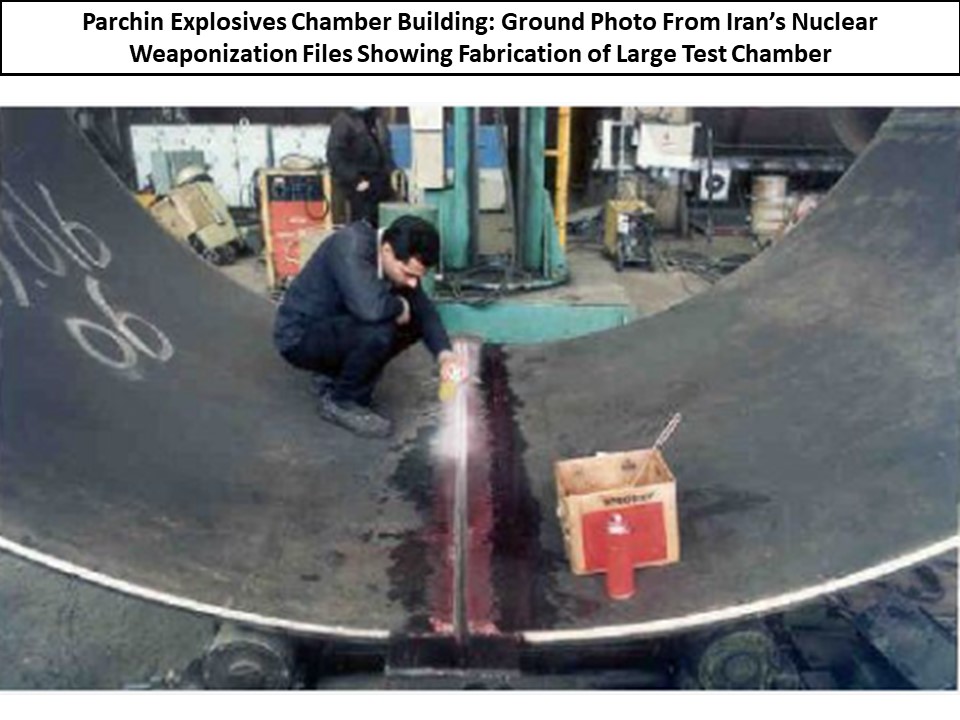

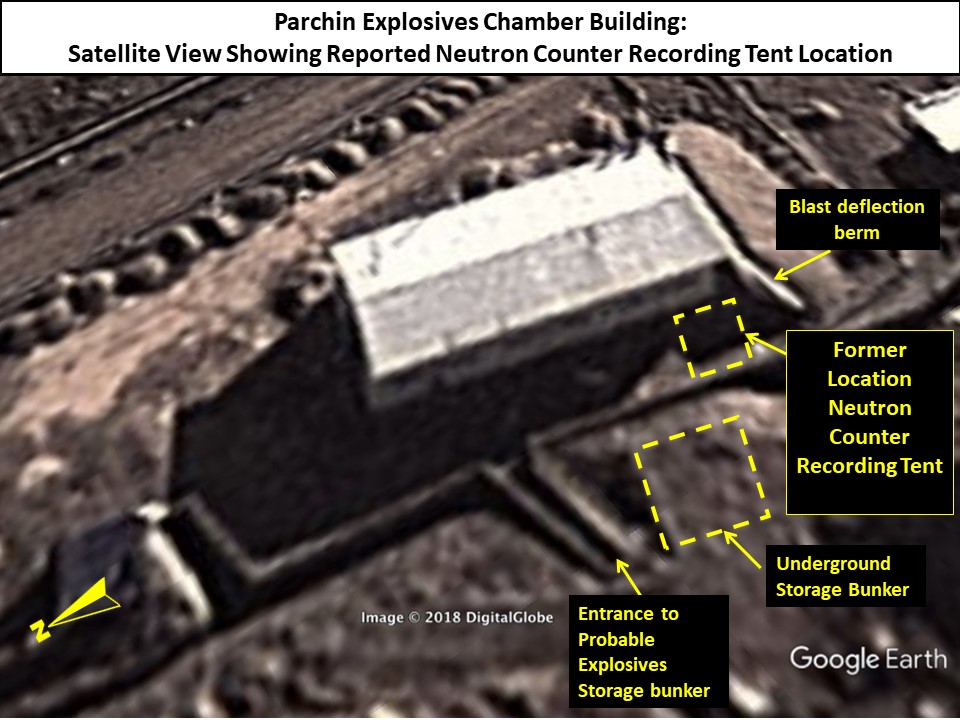
 twitter
twitter